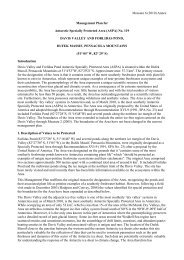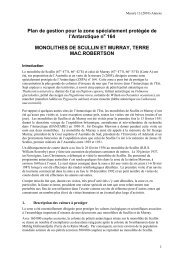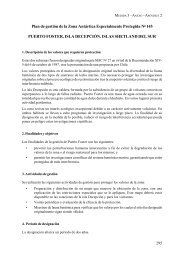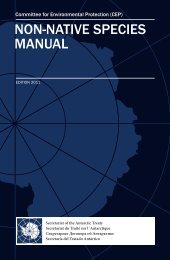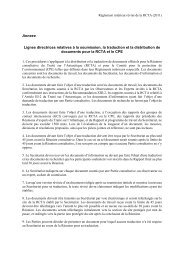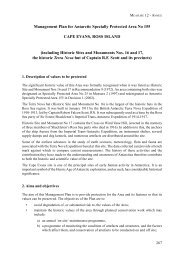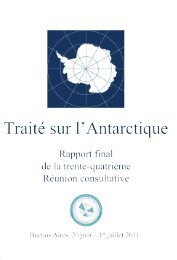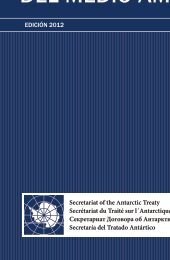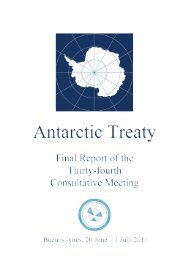Dakshin Gangotri Glacier - Antarctic Treaty Secretariat
Dakshin Gangotri Glacier - Antarctic Treaty Secretariat
Dakshin Gangotri Glacier - Antarctic Treaty Secretariat
You also want an ePaper? Increase the reach of your titles
YUMPU automatically turns print PDFs into web optimized ePapers that Google loves.
Measure 12 (2010) AnnexManagement Plan for<strong>Antarctic</strong> Specially Protected Area (ASPA) No 163:<strong>Dakshin</strong> <strong>Gangotri</strong> <strong>Glacier</strong>, Dronning Maud Land1. IntroductionIndia introduced a Working Paper at XXV ATCM (WP47) on a draft management plan for a proposedsite of Special Scientific Interest for snout of <strong>Dakshin</strong> <strong>Gangotri</strong> <strong>Glacier</strong>, Schirmacher Hills (alsoknown as Vassfjellet), Dronning Maud Land. The Committee noted that this should be termed anASPA rather than SSSI. Accordingly, during XXVI ATCM India submitted a draft management planfor <strong>Antarctic</strong>a Specially Protected Area (XXVI ATCM/WP-38) and thereafter submitted revisedmanagement plan during XXVII-ATCM (WP 33). The management plan was adopted by Measure 2(2005) and designated ASPA 163 during XXVIII ATCM (WP 25).<strong>Dakshin</strong> <strong>Gangotri</strong> glacier has significant value in terms of glacier retreat monitoring. A snout is beingmonitored since 1983 to understand the effect of climate change on glacier. This area is also importantfor study of algae, moss, cynobacteria and lichen which are wide spread in Schirmacher Hills andespecially within the ASPA site. Cynobacteria contribute significantly to the nitrogen fixation, andmany species have been identified so far from this area. Many species of lichens are also indentified inthis area according to study conducted since 2003.2. Description of values to be protectedi. Historic Value<strong>Dakshin</strong> <strong>Gangotri</strong> <strong>Glacier</strong> is a small tongue of polar continental ice sheet, overriding the SchirmacherHills in central Dronning Maud Land (CDML). It was identified by the second Indian <strong>Antarctic</strong>Expedition in 1982-83 and since then its snout is being monitored regularly for fluctuation w.r.t.retreat/advance.ii. Scientific ValueWith the availability of the vast amount of data for the past two decades, it has become a valuable sitefor observing the changes in the movement of the <strong>Antarctic</strong> ice sheet under the impact of globalwarming. The area has primary scientific importance for glaciologists and environmental scientists.Due to The scientific values of the Area and the nature of the research, the area is protected as an<strong>Antarctic</strong> Specially Protected Area consistent with Articles 2, 3, 5 and 6 of Annex V of the Protocol onEnvironmental Protection to the <strong>Antarctic</strong> <strong>Treaty</strong>; to prevent interference with ongoing plannedscientific investigations.Global positioning system (GPS) campaigns were conducted during the 2003 and 2004 austral summerseasons to obtain insight into the velocity and strain-rate distribution on the margin of the continentalice sheet overriding southern part of Schirmacher Hills in CDML. GPS data were collected for twoyears at 21 sites and analyzed to estimate the site coordinates baselines and velocities. Horizontalvelocities of the glacier sites lie between 1.89±0.01 and 10.88±0.01 m a-1 to the north-northeast, withan average velocity of 6.21±0.01 m a-1. The principal strain rates provide a quantitative measurementof extension rates, which range from (0.11±0.01) × 10-3 to (1.48±0.85) × 10-3 a-1, andshortening rates, which range from (0.04±0.02) × 10-3 to (0.96±0.16) × 10-3 a-1 (Sunil et al., 2007).
ATCM XXXIII Final Report0Biii. Environmental ValueAt the designated area, exploration showed abundant faunal diversity of the moss-inhabiting terrestrialinvertebrate fauna. Schirmacher Hills is also an important area for the algae and cyanobacterialdiversity. Terrestrial mosses are quite widespread in the Schirmacher Hills colonizing on a wide rangeof habitats. The mosses, because of their poikilohydric nature and alternative strategy of adaptation,are one of the plant groups which grow in <strong>Antarctic</strong>a. Mosses play role in habitat modification,nutrient cycling and providing shelter and security to associated invertebrate animals. Studies onmosses in Schirmacher Hills revealed that distribution of mosses is significant at central part and atdesignated area as compare to eastern and western part.Distribution of algae and cyanobacteria and flora of fresh water streams of the Hills at the designatedarea have been studied. The species reported are G.magma, Chaemosiphon subglobosus, Oscillatorialimosa, O.limnetica,P. frigidum, P. autumnale, Nostoc commune, N.punctiforme, Calothrix gracilis,C.brevissima, Uronema sp.,and Cosmarium leave. Among the cyanobacteria encountered in the streamof Schirmacher Hills, N 2 –fixing species might play a significant role in nitrogen economy of theecosystem through N 2 –fixation. Studies on polar Skuas were also conducted at Schirmacher Hills andtheir nesting and breeding success have been reported around the designated place.Further study on the Lichens carried out since 2003-04 within the protected area site, revealedoccurance of species such as; Acarospora geynnii , C.W.Dodge & E.D.Rudolph, Acarosporawilliamsii, Filson, Amandinea punctata,(Hoffm.) Coppins & Scheid, Buellia frigida, Darb., Buelliagrimmiae, Filson, Candelaria murrayi, Poelt, Candelariella flava , (C.W.Dodge & G.E. Baker),Castello & Nimis, Carbonea vorticsa, (Florke) Hertel, Lecanora expectans , Darb., Lecanorafuscobrunnea , C.W. Dodge & G.E. Baker, Lecanora geophila (Th. Fr.) Poelt, Lecidea andersonii,Filson, Lecidea cancriformis , C.W.Dodge & G.E. Baker, Lecidella siplei , (C.W. Dodge & G.E.baker) May., Lepraria cacuminum , (A. Massal.) Lohtander, Physcia caesia , (Hoffm.) Furnr.,Pseudephebe minuscule , (Nyl. Ex Arnold) Brodo & D. Hawksw., and Rhizoplaca melanophtalma,(Ram.) Luckert & Poelt (Olech et al., 2010).3. Aims and ObjectivesManagement of <strong>Dakshin</strong> <strong>Gangotri</strong> <strong>Glacier</strong> is aimed to:• avoid degradation of values of the Area by preventing undue human interference• allow glaciological and environmental scientific research, while ensuring protection ofobservational accuracy from any sort of man-made inputs• ensure that peripheral points along the snout are not adversely affected by human activity inthe Area• maintain the Area as a reference marker for studying the movement patterns of this part of the<strong>Antarctic</strong> ice-sheet under the influence of global warming• allow visits for management purposes in support of the aims of the Management Plan for theArea• minimize the possibility of introduction of alien plants, animals and microbes into the Area4. Management ActivitiesThe following management activities will be undertaken to protect the values of the Area:• A detailed map showing the location and boundaries of the Area and stating the specialrestrictions that apply would be displayed prominently at Maitri (India) and Novolazarevskaya(Russia) research stations; copies of this management plan will also be made available at boththe stations.• Two signs displaying the location and boundaries of the Area with clear statements of entry
ASPA 163 - <strong>Dakshin</strong> <strong>Gangotri</strong> <strong>Glacier</strong>restrictions will be placed on prominent rocks near both the entrance points to the valley, theeastern end and the south-eastern end; to help avoid inadvertent entry.• Copies of this management plan along with location and boundary maps of the Area will beprovided to all the visiting ships/aircraft.• Markers, signs, cairns and other structures erected within the Area for scientific andmanagement purposes will be secured and maintained in good condition, and will be removedwhen no longer necessary.• Visits shall be made as necessary (at least once every year) to assess whether the Areacontinues to serve the purposes for which it was designated and to ensure that maintenanceand management are adequate.• The management plan shall be reviewed no less than once every five years and updated asrequired.5. Period of DesignationThe ASPA is designated for an indefinite period.6. MapsThe following maps and photographs are enclosed for illustrating the Area and the proposed plan:Map 1: Location of Schirmacher Hills in central Dronning Maud Land, East <strong>Antarctic</strong>a.Map2: Map of Schirmacher Hills, showing locations of Maitri Research Station (India) andNovolazarevskaya Research Station (Russia).Map 3: Classification and Numbering of Lakes of Schirmacher Hills. (after Ravindra et al, 2001)Map 4: Topographic map of the Area. (contour interval 10 m)Map 5: Paths of Fossil <strong>Glacier</strong>s in Schirmacher Hills. (after Beg et al, 2000)Map 6: Aerial view of the Snout of <strong>Dakshin</strong> <strong>Gangotri</strong> <strong>Glacier</strong>.Figure 1: Image showing the markers showing boundary location of ASPA7. Description of the Area1Bi. Geographical coordinates, Boundary markers and Natural featuresSchirmacher Hills is a rocky hill range, about 17 km long in E-W trend (bounded by Easternlongitudes 11° 22' 40" and 11° 54' 20") and about 0.7 km to 3.3 km wide (bounded by Southernlatitudes 70° 43' 50" and 70° 46' 40"). Its elevation varies from 0 to 228 m above the msl. It is a part ofcentral Dronning Maud Land in Eastern <strong>Antarctic</strong>a. The proposed area is a fragment of the westernpart of Schirmacher Hills.The Area proposed under ASPA is bounded by Eastern longitudes 11° 33' 30" and 11° 36' 30" and bythe Southern latitudes 70° 44' 10" and 70° 45' 30". The Area is 4.53 sq. km in aerial extent. Thenortheastern and northwestern corners of the Area are on shelf-ice, while the southwestern extremity ison polar ice-sheet. The southeastern end lies on a rocky outcrop.Topographically, the Area can be divided into four distinct units- the southern continental ice-sheet,rocky hill slopes, a vast central proglacial lake (Lake-B7, Sbrosovoye Lake) and northern undulatoryshelf ice.The southernmost ice-sheet is bare 'blue ice', descending from 180 m contour to 10 m contour at thesnout of the <strong>Glacier</strong>. It is crevassed and crisscrossed by NE-SW to NNE-SSW trending fractures. Twosmall and ephemeral supraglacial streams flow over the snout in a NNE direction.The rocky terrain is uneven and has the minimum width of the Schirmacher Hills at the snout point;3
ATCM XXXIII Final Reportless than 50 m only. The eastern and western sides of the hills slope towards the snout, making a widevalley. The contours descend from 150 m to msl at the northern margin of the rock outcrops.The central part of the Area is occupied by Lake B7. It is a lake of glacial origin. The dimensions ofthe lake are about 500 m x 300 m.The northernmost part of the Area comprises shelf ice with pressure ridges, fractures and crevasses.The contact between shelf ice and eastern rocky slopes is marked by a prominent 3-km long, NNE-SSW trending lineament. The fractures in the ice are also aligned parallel to this lineament.Schirmacher Hills exposes a granulite to amphibolite facies metamorphic terrain. The rock types arerepresented by charnockites, enderbites, garnet-sillimanite, gneisses, garnet-biotite gneisses,quartzofeldspathic augen gneisses with some foliated lamprophyres, amphibolites, dolerite,metagabbro and metabasalt. The rock suites dominantly fall under Grenvillean (1000 Ma) and Pan-African (550 Ma) events. Three phases of deformation are distinct.The Area comprises mostly charnockite-Khondalite type of rocks (quartz-garnet-sillimaniteperthite±graphitegneisses) with some interlayering of garnet-sillimanite quartzites, calc silicategneisses and mafic granulites. Two sets of faults (N30E and N50E) are quite prominent. One suchmajor fault runs from the north-eastern corner of the Area; cutting all the three geomorphologicalunits- shelf ice, rocks and continental ice-sheet.Meteorological data from the nearby Indian Research Station Maitri shows that the Area has a drypolar climate. The extreme temperatures for the warmest and the coldest months range between 7.4 to-34.8°C. The mean annual temperature is -10.2°C. December is the warmest month of the year andAugust is the coldest. The blizzards touch a gale speed of 90 to 95 knots; the mean annual wind speedis 18 knots. The dominant wind direction is E-SE. Snowfall is quite frequent during the winter months,but gale force winds scrub the rocky surfaces clean and snow deposition is widespread on the leewardside of the hillocks.Glaciological observations from 1983 to 1996 were carried out by surveys from two fixed points (‘G’and ‘H’) using EDM or theodolite. The results showed that the <strong>Glacier</strong> is steadily receding every yearat an average recession rate of 70 cm per annum.In 1996, to enhance the accuracy of the observations, 19 peripheral points were marked encircling thesnout of the <strong>Glacier</strong>. The average annual recession in the years 1997 to 2002 was 48.7 cm, 74.9 cm,69.5 cm, 65.8 cm and 62.7 cm, respectively. This translates into an overall average recession of 65.3cm per annum for the period 1996-2002; which is in conformity with the observations for the previousperiod (1983 – 1996) of a recession rate of 7 meters per decade.Further monitoring were carried out and data revealed that average yearly recession for 2003, 2004,2005 and 2006, gradually increased to 68.0, 69.4, 71.3, 72.8 cm per annum. However during the year2006-2007, the average retreat of the <strong>Dakshin</strong> <strong>Gangotri</strong> polar ice front was only 0.6 m, but the datacollected from the western margin of Schirmacher Hills showed an average annual retreat of around1.4 m during the year 2006-07. The average annual retreat of the snout of <strong>Dakshin</strong> <strong>Gangotri</strong> wasrecorded to be about 1m in 2008, whereas the average annual retreat for the western extension of polarice front was recorded to be about 2m. The maximum recession was observed at observation-point-14,which recorded a cumulative recession of 17.21 meters in ten years (1996-2006).2Bii. Restricted and Managed Zones within the AreaAlong the periphery of the <strong>Dakshin</strong> <strong>Gangotri</strong> <strong>Glacier</strong>, 19 observation points have been marked inFebruary 1996. With reference to these points it was possible to record the movement of the <strong>Glacier</strong>with an accuracy of 1 cm. Precise monitoring on cm-scale is also available for the years 1996-2002.Access to this zone should be restricted. To protect the accuracy of scientific observations,it isproposed that a 100 m radius all along the periphery of the <strong>Glacier</strong> should have limited admittance.3Biii. Structures within and near the AreaThere are no structures present in the Area, apart from two cairns (‘G’ and ‘H’) marking the sites usedfor glaciological and topographical surveys.
ASPA 163 - <strong>Dakshin</strong> <strong>Gangotri</strong> <strong>Glacier</strong>In future, some signs and cairns will be erected notifying the protected status of the Area.4Biv. Location of other Protected Areas within close proximity of the AreaIn the entire Schirmacher Hills, there are no other protected areas.8. Permit Conditionsa) Access to and movement within the AreaEntry into the Area would be prohibited except in accordance with a permit issued by an appropriateNational Authority as designated under Annex V, Article 7 of the Protocol on EnvironmentalProtection to the <strong>Antarctic</strong> <strong>Treaty</strong>.A permit to enter the Area may only be issued for scientific research, or for essential managementpurposes consistent with the Management Plan’s objectives and provisions; with the condition that theactions permitted will not jeopardize the scientific and environmental values of the Area and will notinterfere with ongoing scientific studies. Access to the area is permitted only by foot, access to siteusing land vehicle or helicopter landing is prohibited within the area.b) Activities that are or may be conducted within the Area, including restrictions on time orplaceThe following activities may be conducted within the Area:• Scientific research programmes consistent with the management Plan for the Area, includingthe values for which the Area has been designated; which can not be carried out elsewhere andwhich will not jeopardize the ecosystem of the Area.• Essential management activities, including monitoring.c) Installation, modification or removal of structuresNo structures are to be erected within the Area except as specified in a permit. Any equipment shouldnot be installed if it is not essential for scientific research or for management activities, and it must beauthorized in a permit. All scientific equipment installed in the Area must be clearly identified bycountry with name of principal investigator, year of installation and expected date of completion of thestudy. Details are to be included in the visit report. All such equipment should be made of materialsthat pose minimum risk of contamination and must be removed immediately after completion of thestudy. Removal of specific equipment for which the permit has expired shall be a condition of thepermit.d) Location of field campsCamping is not allowed in the Area. The field parties can camp either 1000 meters away fromthe eastern edge of Lake B7 (Sbrosovoye Lake ) or 500 meters away from the western edge ofsame lakee) Restriction on materials and organisms, which can be brought into the AreaNo living animals, plant material or microorganism shall be deliberately introduced into the Area andprecautions shall be taken against accidental introductions.• No pesticides, herbicides, chemicals, radio-isotopes shall be brought into the Area, other thanthose permitted for scientific or management purposes. These authorized agents shall beremoved from the Area at the conclusion of the activity.5
ASPA 163 - <strong>Dakshin</strong> <strong>Gangotri</strong> <strong>Glacier</strong>Supporting BibliographyASTHANA R., GAUR M.P., CHATURVEDI, A. (1996): Notes on Pattern of SnowAccumulation/ablation on ice shelf and Secular Movement of <strong>Dakshin</strong> <strong>Gangotri</strong> <strong>Glacier</strong> Snout inCentral Dronning Maud Land, East <strong>Antarctic</strong>a. In: scientific Report of the Twelfth Indian ScientificExpedition to <strong>Antarctic</strong>a, Tech. Pub. No. 10 D.O.D., Govt. of India, New Delhi, pp.111-122.BEG M.J., PRASAD A.V.K., CHATURVEDI, A. (2000): Interim Report on Glaciological Studiesin the Austral Summer of 19 th Indian <strong>Antarctic</strong> Expedition. In: Scientific Report of Nineteenth IndianExpedition to <strong>Antarctic</strong>a, Tech. Pub. No. 17, D.O.D., Govt. of India, New Delhi, pp. 121-126.BEJARNIYA B.R., RAVIKANT V., KUNDU A. (2000): Glaciological Studies in Schirmacher Hilland on Ice Shelf during XIV <strong>Antarctic</strong>a Expedition. In: Scientific Report of Sixteenth IndianExpedition to <strong>Antarctic</strong>a, Tech. Pub. No. 14, D.O.D., Govt. of India, New Delhi, pp. 121-126.CHATURVEDI A., SINGH A., GAUR M.P., KRISHNAMURTHY, K.V., BEG M.J. (1999): Aconfirmation of Polar Glacial Recession by Monitoring the Snout of <strong>Dakshin</strong> <strong>Gangotri</strong> <strong>Glacier</strong> inSchirmacher Range. In: Scientific Report of Fifteenth Indian Expedition to <strong>Antarctic</strong>a, Tech. Pub. No.13, D.O.D., Govt. of India, New Delhi, pp. 321-336.D'SOUZA M.J., KUNDU A. (2000): Glaciological studies during the Seventeenth <strong>Antarctic</strong>Expedition. In: Scientific Report of Seventeenth Indian Expedition to <strong>Antarctic</strong>a, Tech. Pub. No. 15,D.O.D., Govt. of India, New Delhi, pp.67-72.KASHYAP A.K. (1988.): Studies on Algal flora of Schirmacher Oasis, Dronning Maud land,<strong>Antarctic</strong>a . In: Proceedings of Workshop on <strong>Antarctic</strong> Studies, D.O.D.,CSIR, Govt. of India, NewDelhi, pp.435-439KAUL M.K., CHAKRABORTY S.K., RAINA V.K. (1985): A Note on the snout of the <strong>Dakshin</strong><strong>Gangotri</strong> <strong>Glacier</strong>, <strong>Antarctic</strong>a. In: Scientific Report of Second Indian Expedition to <strong>Antarctic</strong>a, Tech.Pub. No. 2, D.O.D., Govt. of India, New Delhi, pp. 91-93.KAUL M.K., SINGH R.K., SRIVASTAVA D., MUKERJI S., JAYARAM S. (1998): Observationson the Changes in the Snout of <strong>Dakshin</strong> <strong>Gangotri</strong> <strong>Glacier</strong>, <strong>Antarctic</strong>a. In: Scientific Report of the FifthIndian Expedition to <strong>Antarctic</strong>a, Tech. Pub. No. 5, D.O.D., Govt. of India, New Delhi, pp. 205-209.MUKERJI S., RAVIKANT V., BEJARNIYA B.R., OBEROI L.K., NAUTIYAL S.C. (1995): ANote on the Glaciological Studies Carried Out During Eleventh Indian Expedition to <strong>Antarctic</strong>a. In:Scientific Report of Eleventh Indian Expedition to <strong>Antarctic</strong>a, Tech. Pub. No. 9, D.O.D., Govt. ofIndia, New Delhi, pp. 153-162.OLECH M., SINGH S.M. (2010) : Lichens and Lichenicolous Fungi of Schirmacher Oasis,<strong>Antarctic</strong>a. Monograph, National Centre for <strong>Antarctic</strong> and Ocean Research, India. NISCAIR, NewDelhi (In press).PANDEY K.D., KASHYAP A.K. (1995): Diversity of Algal Flora in Six Fresh Water Streams ofScirmacher Oasis, <strong>Antarctic</strong>a. In: Scientific Report of Tenth Indian Expedition to <strong>Antarctic</strong>a, Tech.Pub. No. 8, D.O.D., Govt. of India, New Delhi, pp. 218-229.RAVINDRA R., CHATURVEDI A. AND BEG M.J. (2001): Melt Water Lakes of SchirmacherOasis - Their Genetic Aspects and Classification. In: Advances in Marine and <strong>Antarctic</strong> Science, Ed.Sahu, DB and Pandey, PC, Dariyaganj, New Delhi, pp. 301-313.7
ATCM XXXIII Final ReportRAVINDRA R., SRIVASTAVA V.K., SHARMA B.L., DEY A., BEDI, A.K. (1994): Monitoringof Icebergs in <strong>Antarctic</strong> Waters and a Note on the Secular Movement of <strong>Dakshin</strong> <strong>Gangotri</strong> <strong>Glacier</strong>. In:Scientific Report of Ninth Indian Expedition to <strong>Antarctic</strong>a, Tech. Pub. No. 6, D.O.D., Govt. of India,New Delhi, pp. 239-250.RAVINDRA, R. (2001): Geomorphology of Schirmacher Oasis, East <strong>Antarctic</strong>a. Proc. Symp. onSnow, Ice and <strong>Glacier</strong>s, Geol. Sur. India, Spl. Pub. No. 53, pp. 379-390.SINGH D.K., SEMWAL R.C. (2000): Bryoflora of Schirmacher Oasis,East <strong>Antarctic</strong>a: APreliminary Study. In: Scientific Report of Sixteenth Indian Expedition to <strong>Antarctic</strong>a, Tech. Pub. No.14, D.O.D., Govt. of India, New Delhi, pp.173-186SUNIL P.S., REDDY C.S., PONRAJ M., DHAR A., JAYAPAUL D. (2007) : GPS Determinationof the Velocity and Strain-Rate Fields on Schirmacher <strong>Glacier</strong>, Central Dronning Maud Land,<strong>Antarctic</strong>a. Journal of Glaciology, vol. 53, pp. 558-564.VENKATARAMAN K. (1998): Studies on Phylum Tardigrada and Other Associated Fauna, SouthPolar Skua and Bird and Mamal Ligging during 1994-1995 Expedition. In: Scientific Report ofFourteenth Indian Expedition to <strong>Antarctic</strong>a, Tech. Pub. No. 12, D.O.D., Govt. of India, New Delhi,pp.220-243
ASPA 163 - <strong>Dakshin</strong> <strong>Gangotri</strong> <strong>Glacier</strong>1
ATCM XXXIII Final Report
ATCM XXXIII Final Report
ASPA 163 - <strong>Dakshin</strong> <strong>Gangotri</strong> <strong>Glacier</strong>1
ATCM XXXIII Final Report
ASPA 163 - <strong>Dakshin</strong> <strong>Gangotri</strong> <strong>Glacier</strong>1



